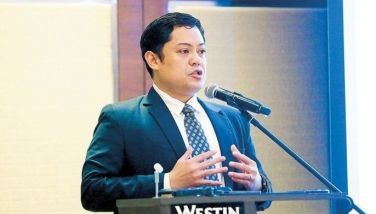Preparing for visitors

We like to think of ourselves as hospitable people. If this is true, we have a good basis for a solid tourism industry. Unfortunately, we are losing that welcoming spirit. Instead, scamming visitors starting at the airport has become our unfortunate international reputation. We also have third world infrastructure which makes us uncompetitive compared to our regional neighbors.
Among the ASEAN 5, we recorded the least number of visitor arrivals at 5.4 million last year. That’s nowhere near the 28 million of Thailand, 13 million of Singapore, 12.6 million of Vietnam and 11.6 million of Indonesia. I do not have the data for Cambodia and Laos but both have shown the fastest post-COVID recovery. Cambodia may have overtaken us by now.
We should be nurturing our tourism industry through good leadership and significant infrastructure investments. Mother Nature has given us a fantastic natural resource but we have proven incapable of developing our potential properly. Tourism can help move the economy and improve the quality of our people’s lives in the countryside.
Our government is not spending enough to attract visitors and the little budget DOT gets is not spent properly to produce maximum positive results. The proper measure of DOT’s effectiveness is a significant increase in the number of visitors who come here and how much they spend.
The DOT must fully support its attachés who are the foot soldiers in promoting the tourism industry. That’s better than spending on the travels of Manila-based tourism officials.
According to Statista, in 2022, the travel and tourism industry contributed just over $241.7 billion to the GDP in Southeast Asia. Comparatively, this value was $379.9 billion in 2019. GDP contributions from this industry in Southeast Asia saw consistent increases throughout the past decade until they halved in 2020 due to the global pandemic.
According to the ASEAN Statistical Brief, the region’s tourism industry has yet to get back to pre-pandemic level. In the first half of 2023, tourism’s recovery was only at 66 percent. Around 46.5 million visitors travelled to ASEAN with around 43 percent from the region too. The pre-pandemic visitor level was at 143.6 million. This gives us time to get our house in order so we can catch up.
Traditional Filipino customs require us to fix our house to make a good impression on guests. We have neglected this with our airports for decades. Airports give a first and often lasting impression on visitors and we have been telling the world how third world we are as a country. Those of us who have experienced going through international airports in the region and in the Middle East know what acceptable world standards are.
The privatization of NAIA’s management should get us closer to world-class. Ramon Ang told a group of columnists last week that he had started to purchase facilities that need to be urgently changed at NAIA but has been neglected because of the government procurement process. He is also studying new technology being used in airports abroad that will facilitate processing of passengers and drastically improve passenger experience at NAIA.
One of the new systems RSA is looking at involves making security processing at NAIA quick, accurate and not an inconvenience. He is looking at replacing outdated scanning systems with advanced computerized tomography (CT) X-ray machines at the airport security checkpoints. I googled it and found a Channel News Asia article that said this type of machine had already been implemented since 2015 in various airports around the world.
Briefly, these CT scanners generate three-dimensional views, allowing security personnel to rotate images and inspect the contents of hand luggage from different angles. By screening more individuals within a shorter time span, this technology allows lines to move more quickly, helping airports avoid delays and passengers experience less stressful journeys.
CNA reports that while implementation varies across airports, with the CT scanners, passengers will no longer be required to remove electronics or liquids from their bags. However, they must still be kept in containers of not more than 100ml each.
Different airports worldwide have different requirements even with this system. Hong Kong and Incheon in South Korea introduced smart security screening in September 2022.
By 2025, all departure and transfer areas are expected to be equipped. In Singapore, it is available in Terminal 4.
At Doha, Qatar, smart screening was introduced back in June 2021 that includes a shoe scanner so passengers don’t have to remove their footwear.
And so it goes with many other airports in Australia, New Zealand and Europe. We have simply been left behind. And it is not because we don’t have funds to buy state-of-the-art equipment. We simply have clueless, unimaginative airport bureaucrats.
RSA is also looking at the facial recognition system used in Shenzhen. Once a passenger checks in, his biometric data is recorded and his boarding pass and luggage tags will have this data. In Shenzhen, they are even able to determine where in the airport terminal a passenger is.
One of RSA’s priorities is the construction of two quick exit taxiways on runway 06 so an aircraft that just landed can quickly get out of the single runway. That will enable NAIA to process more landings and take-offs.
Of course, all these will need money. NAIA’s landing and take-off rates have not been changed for 24 years and inflation has gone up by 140 percent since then. But domestic carriers have a 65 percent discount on rates so their local fares shouldn’t be too affected. Hopefully, the airlines would help absorb some of those costs since they will benefit from the resulting efficient airport operations.
RSA still plans to get Bulacan Airport up and running before BBM’s term expires. That means we will have two international quality airports to bring in visitors. All we need is a good program to welcome them and make their stay here memorable.
Boo Chanco’s email address is [email protected]. Follow him on X @boochanco.
- Latest
- Trending





























